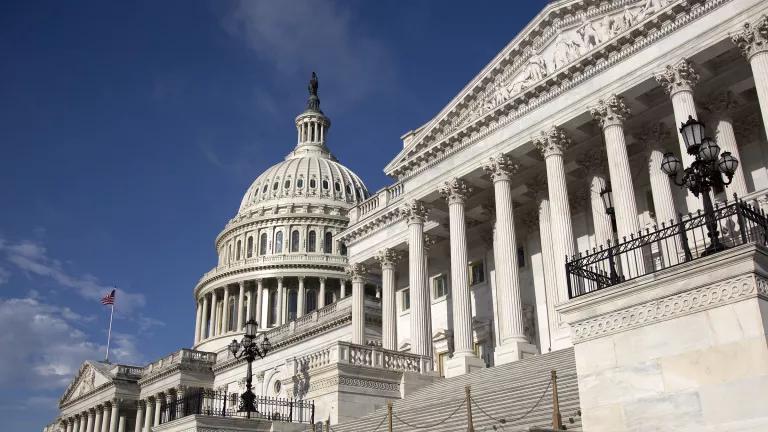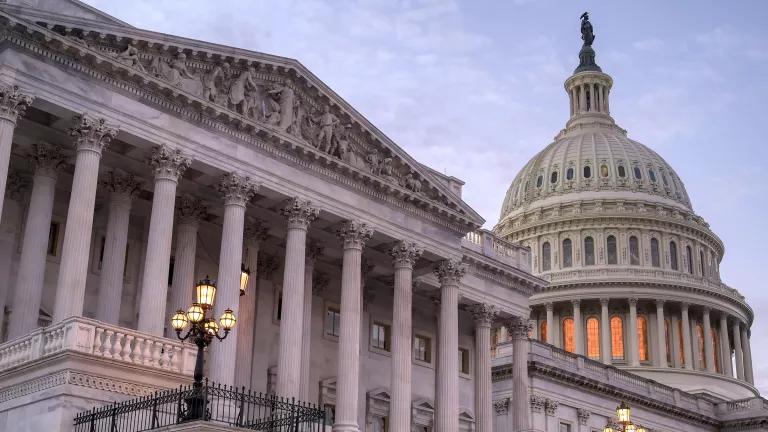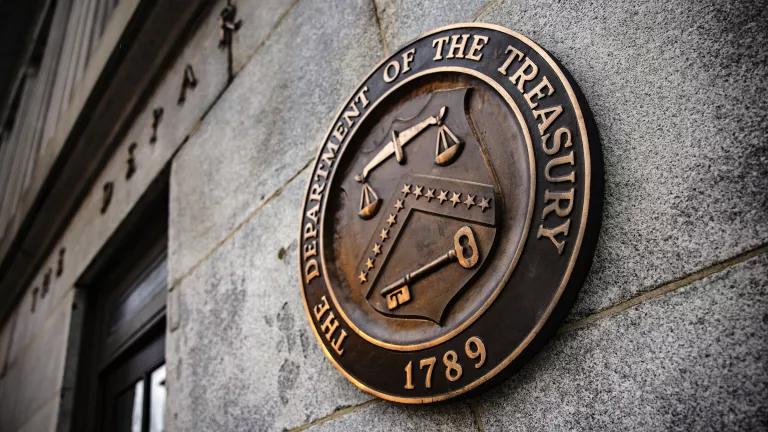Extreme Weather and COVID-19: Protecting Our Responders
Climate-fueled extreme weather disasters have not stopped during this pandemic. At the forefront are professional responders and volunteers who bear the brunt of these two converging crises.

Oregon firefighters in COVID-19 personal protective equipment.
Climate-fueled extreme weather disasters have not stopped during this pandemic. In fact, this year has been riddled with an onslaught of record-breaking weather disasters in the U.S., from hurricanes to wildfires to extreme heat. Tragedy after tragedy, communities are struggling to respond to both COVID-19 and the aftermath of these disasters at the same time. At the forefront are professional responders and volunteers who bear the brunt of these two converging crises.
Strained emergency response resources, lack of personnel, and challenging procedural shifts to reduce further spread of the virus have added an additional layer of complexity to recovery and response measures. These are just a few of the challenges plaguing responders during this pandemic, in addition to the hazards they face following a disaster. Their safety and health are paramount, and solutions such as increased investments in the public sector, stronger workplace safety enforcement, and preventative measures for COVID-19 must be put in place to support them.
A Record Year for Climate-Fueled Weather Disasters
This year, the United States saw 16 billion-dollar weather and climate disasters through early October.
The 2020 Atlantic hurricane season had the most named storms on record: 30 tropical storms, 13 hurricanes, and six major hurricanes. Hurricanes Laura and Sally tore through the Southern part of the U.S., devastating areas such as Lake Charles in Southwest Louisiana not once but twice. Communities were left without drinking water, air conditioning, and power in the middle of a sweltering summer. Those deadly storms triggered huge suffering in lives lost, property destroyed, and industries decimated.
As hurricanes hit one part of the country, wildfires tore through another. This wildfire season, California saw a recording breaking year with over 4 million acres burned—more than doubling the state’s previous record. Again: lives lost, communities displaced, and damages upwards of several billions of dollars.
Extreme heat, flooding, and drought also plagued the nation.
These climate-fueled extremes are increasing in frequency, duration and severity—leaving devastation in their wake. All amidst a pandemic.
Response and Recovery During a Pandemic
Over 16 million people in the United States have been infected with COVID-19 and at least 300,000 have died. The uncontrolled spread of the virus has hit many essential industries, including disaster responders.
Since the start of the pandemic, the response community has put in place measures to protect themselves and the public from the virus. Firefighters transformed their usual large camps to smaller “family unit” pods, added additional COVID-19 screening measures, and adjusted evacuation protocols. Even so, the response community has seen its share of infections and fatalities during this pandemic, impacting firefighters, emergency medical services (EMS) personnel, and other responders across the country.

National Guard Servicemembers show support for firefighter who lost his life battling COVID-19.
An Already Broken Health and Safety System
Frontline responders face many threats to their health and safety that stem from the unstable environments following a disaster. Air pollution, extreme temperatures, and exposure to infectious diseases from ticks or mosquitos are just a few of the climate and weather-related hazards they may encounter. Other hazards include electrocution from downed power lines, and exposure to chemicals, infections, or other bacteria and viruses.
During non-pandemic times, these hazards were already a challenge. High rates of injuries are seen among responders across a range of disaster types. For example, after Hurricane Katrina, federal responders reported over 3,000 injuries and illnesses from response and recovery efforts. That number does not include data from all responding agencies and is likely underestimated.
Limited personal protective equipment, risk surveillance, training, and staffing also challenged disaster responders before the pandemic.
Additionally, protecting responders during these disasters has also been made difficult by limited safety enforcement by the Occupational Safety and Health Administration (OSHA). OSHA can decide to temporarily suspend enforcement measures in an attempt to expedite rescue efforts, opting to provide responders technical assistance instead. Time and time again, this practice has been shown to be insufficient as many health and safety issues during disasters have gone unfixed—leaving rescue and recovery responders vulnerable to hazards.
Health and Safety of Volunteers
After a natural disaster, a wide range of individuals dispatch to these areas to provide response and recovery efforts. In addition to professional responders, communities and volunteers all work together to provide aid and relief. Response and recovery can continue for months and even longer after the initial disaster. These volunteers may face similar health and safety challenges that professional, paid responders do, but with even fewer resources. Injuries incurred by volunteers can lead to mental and physical health issues and also loss of income—that are unlikely to be covered by insurance.
Many existing health and safety policies and training are only aimed at professional responders. This leaves community members and volunteers without tools and resources to protect themselves from similar hazards they may encounter.

Louisiana National Guardsmen and volunteers assisting with Hurricane Laura cleanup efforts.
Ensuring Responders are Protected from COVID-19 and Other Hazards
Failure to fully protect disaster responders from COVID-19 and other hazards leaves communities without the support they need during a crisis. To ensure communities and responders are protected we need:
- A stronger OSHA under the Biden-Harris Administration, with increased enforcement and penalties for unsafe working conditions. In particular, the enforcement of OSHA policies during disasters. Congress should direct OSHA to establish a mandatory comprehensive health and safety plan for disaster response and recovery efforts that includes safe work practices, appropriate personal protective equipment, and other workplace safety provisions. In addition, OSHA should issue an Emergency Temporary Standard (ETS) that ensures that workers are protected from COVID-19 in the workplace.
- Federal and state agencies to prioritize responders in the distribution of a COVID-19 vaccine. Responder unions, worker groups, and advocates across the nation have called for this prioritization, stating that the “domino effect” of COVID-19 exposures can negatively impact response efforts.
- To increase the capacity of the public sector to prepare and respond to climate-fueled weather disasters. Our social infrastructure has long been underfunded and neglected, and we need to rebuild and invest in our public sector. Funding, staffing, training and other resources at all levels of government are paramount to provide communities and workers the resources to build resilience before a crisis occurs.
- Congress to provide additional funding to government agencies that work with community groups to develop disaster response and recovery training and materials for professional and volunteer responders. For example, The National Institute of Environmental Health Sciences (NIEHS) Worker Training Program in collaboration with the American Industrial Hygiene Association recently released a guidance document providing resources and information to the volunteer communities on how to protect themselves from COVID-19 during a natural disaster. Additional resources such as this one should be developed.
Climate-fueled weather disasters and COVID-19 have put millions of Americans in danger. These are unprecedented times, and supporting the health and safety of responders is more crucial than ever.


